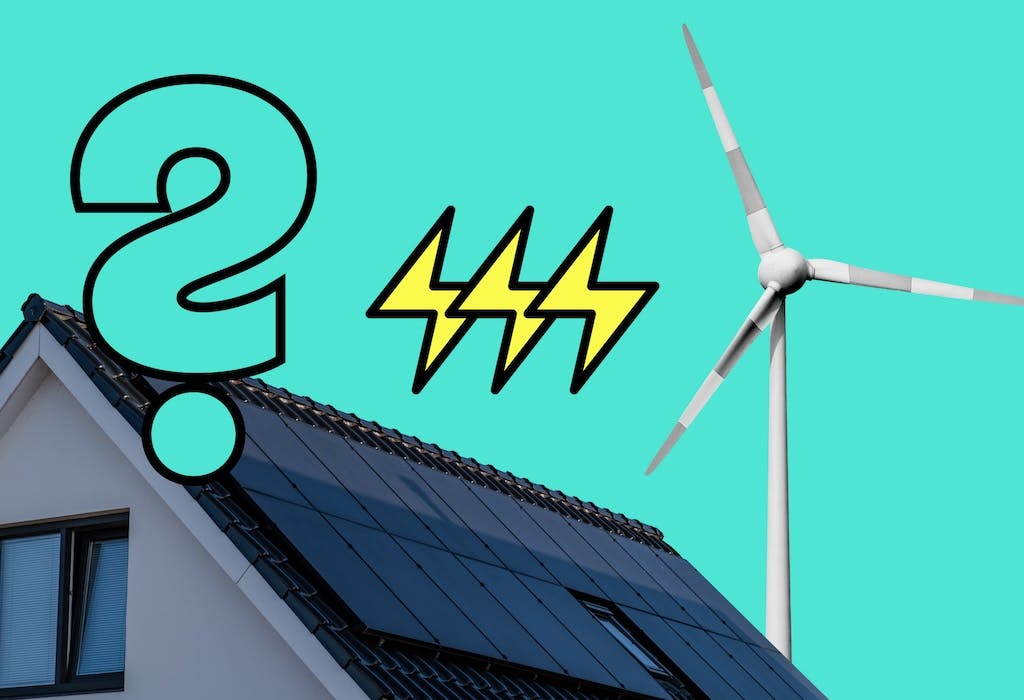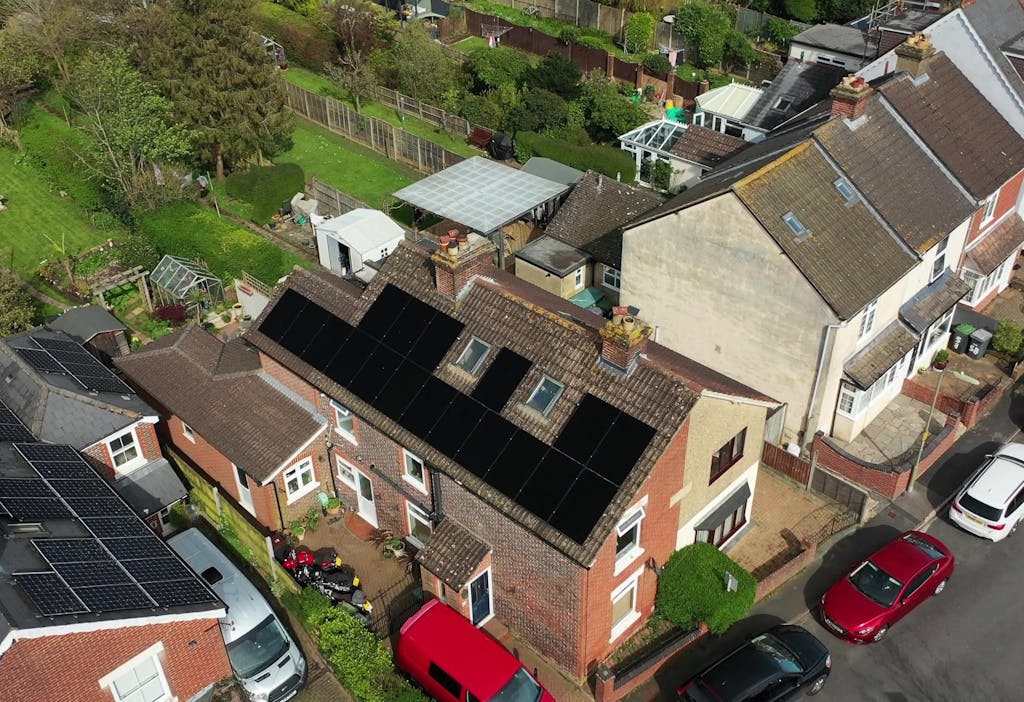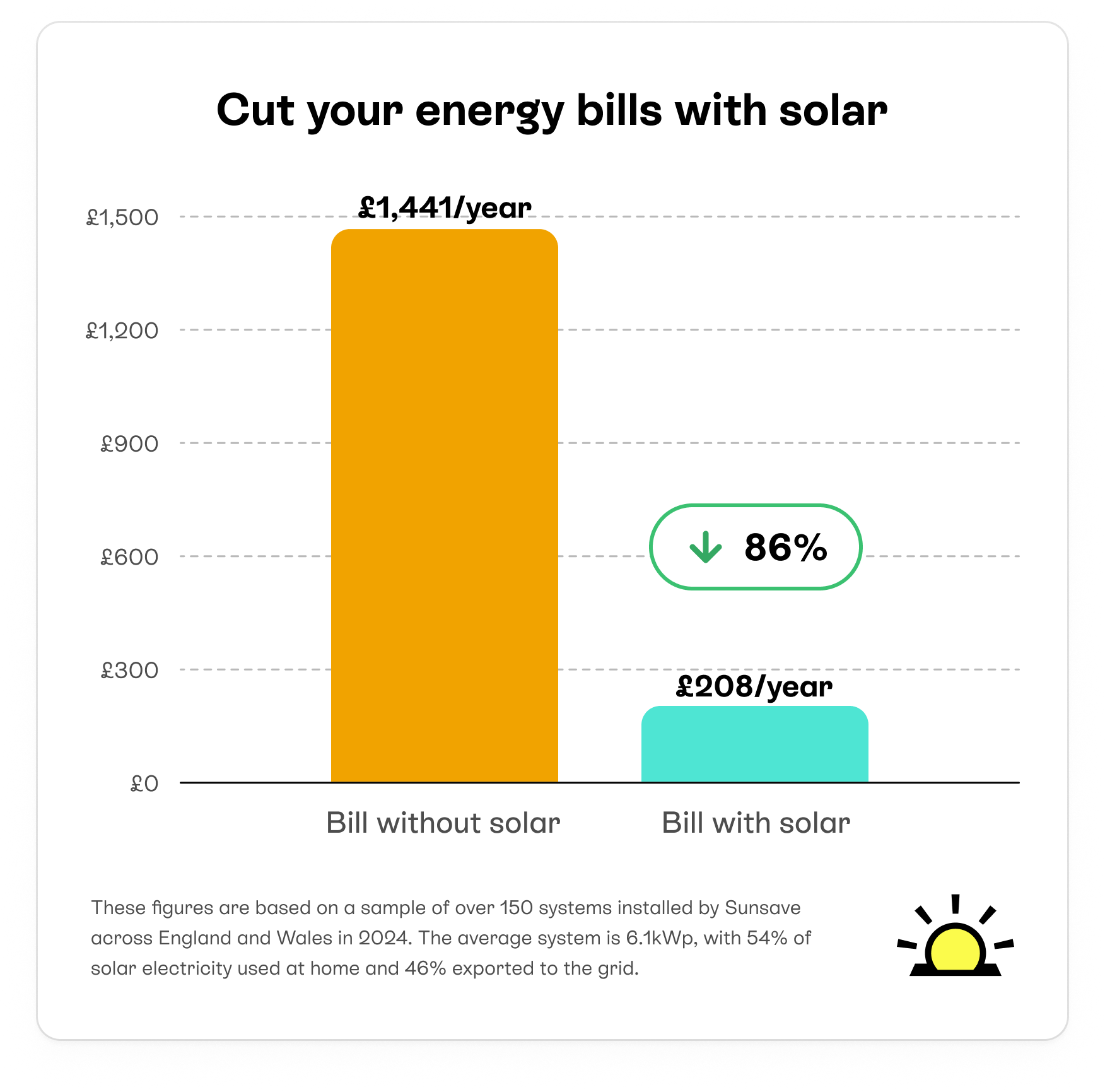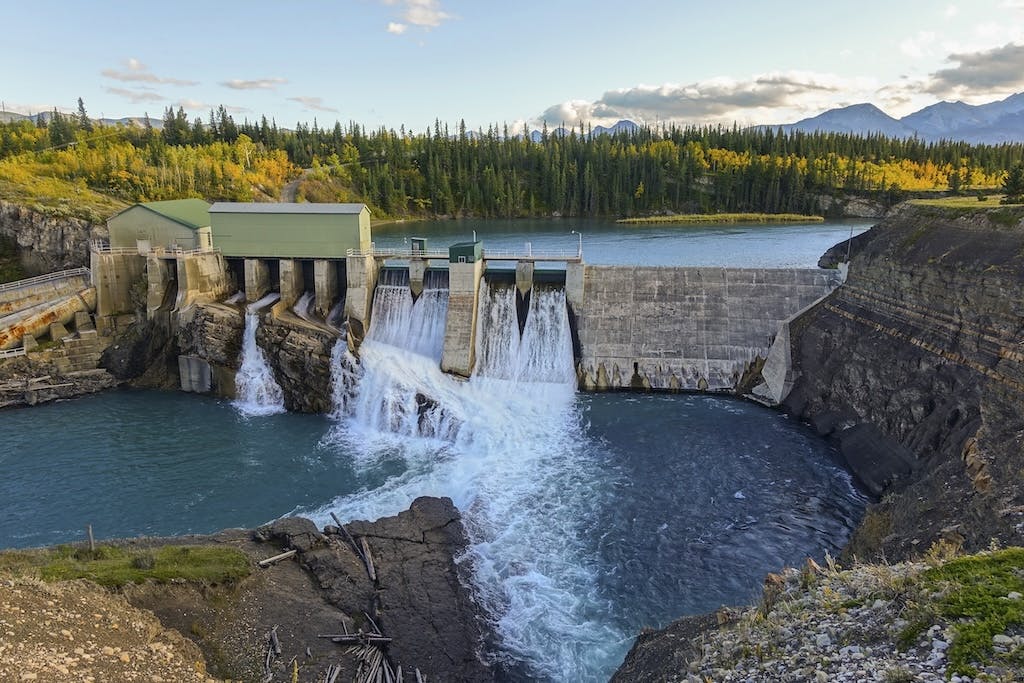How can I generate my own electricity?
Discover the four best ways to produce your own electricity at home, including typical requirements, costs, and potential energy bill savings.
Written byMelody Abeni

Calculate savings
What kind of home do you live in?
Calculate savings
What kind of home do you live in?
At a glance
⚡ There are four main ways to generate electricity at home
☁️ Solar panels work well in the UK, despite our cloudy weather
🏙️ Domestic wind turbines aren’t very effective in built-up areas
🌊 Micro-hydro systems only work at properties situated beside flowing water
🔥 Micro-CHP systems generate heat and electricity simultaneously
With energy bills expected to stay high until at least the late 2030s and electricity demand forecast to soar over the next few decades , it’s no surprise people want to generate their own electricity and shift away from the grid.
In this guide, we’ll break down the four best ways to start producing power at home, including how they work, how much they cost, and how much money they could save you.
Certainly the most accessible route to domestic electricity production is solar panels, as we’ll go on to explain.
If you’re already curious about how much you could save with a solar & battery system, share a few details below and we’ll provide an estimate.
Find out how much you can save
What kind of home do you live in?
The four best ways to generate electricity at home
Renewable energy generation has become a key part of the UK’s electricity mix in recent years.
In 2024, wind power alone provided 30% of the nation’s electricity, while biomass, solar, and hydro contributed 7%, 5%, and 2%, respectively.
These figures largely reflect the success of utility-scale installations like wind farms and solar farms.
But if you’re aiming for energy independence at home, these are the four main routes to consider:
- Solar panels
- Wind turbines
- Hydroelectric systems
- Micro combined heat and power (micro-CHP)
The right choice for you will depend on your property, location, and budget, as some options - like hydro - are only suitable in very specific situations.
Let's explore each of these methods in more detail.
1. Solar panels
Solar panels are devices that convert natural light into electricity using photovoltaic (PV) cells.
Contrary to popular belief, solar panels don't need direct sunlight to work, just daylight, meaning the technology works well in the UK’s cloudy weather.
And our country’s regular rainfall can actually be a benefit, as it keeps the solar panels clean and spares you the cost and hassle of having to do it yourself regularly.
With expert system design and professional installation, solar panels can be a very effective source of electricity for homes across the country.
To learn more, check out our guide to how much energy solar panels produce.
How many UK homes have solar panels?
More than 1.6 million UK households now have solar panels, which represents more than 5% of the country’s 28.6 million homes.
This is a significant increase from fewer than one million homes in 2020, and it's largely been driven by rising energy bills and the gradual improvement of the Smart Export Guarantee (SEG), which pays households for their excess energy.
Most homes don’t need planning permission for solar panels, but you might need permission from your local authority if you live in a listed building or a conservation area.

How much can solar panels reduce your bills?
A solar & battery system can cut your electricity bills by 86%, on average.
This figure is based on a sample of over 150 systems installed by Sunsave across England and Wales in 2024. The average system is 6.1kWp, with 54% of solar electricity used at home and 46% exported to the grid.
Solar panels reduce the amount of electricity you buy from the grid, and you also get paid for any excess that you export to the grid (via a solar export tariff).

How much do solar panels cost?
The cost of solar panels in the UK varies based on several factors, including the size of your system and the quality of the hardware.
Generally speaking, a 4.5 kilowatt-peak (kWp) solar & battery system - which is normally suitable for a two or three-bedroom property - will cost about £10,300.
If you’re put off by the high upfront cost of going solar, you can avoid it entirely with Sunsave Plus, the UK’s first solar subscription. This means you can switch to solar with no upfront cost and instead pay a fixed monthly fee.
Your system will also be protected by the Sunsave Guarantee for the full subscription term, which includes 24/7 monitoring & maintenance, free replacement parts, downtime cover, and insurance.
To find out how much you could save with Sunsave Plus, share a few quick details below and we'll provide an estimate.
Find out how much you can save
What kind of home do you live in?
2. Wind turbines
Wind turbines use the wind's kinetic energy to generate power. As the blades turn, they spin a rotor connected to a generator, which produces electricity.
And whilst people generally associate wind power with vast groups of turbines out at sea or in large fields, there’s also an emerging residential option.
Predictably, domestic wind turbines are much smaller than utility scale ones, with power ratings ranging from 400 watts (W) to 100 kilowatts (kW) , whereas the big onshore wind turbines are about two or three megawatts each.
According to estimates from the US Department of Energy, a 1.5kW turbine in a windy area (with an average wind speed of 14mph) can generate enough electricity for a home using 300kWh per month , which is only slightly more than the UK average.
Domestic wind turbines are handy if you live somewhere that’s particularly exposed and blustery, but they don’t make much sense if you live in a very built up area.
How many UK homes have wind turbines?
There's no data available regarding how many UK homes currently have wind turbines, but as a relatively new and niche technology, we can assume adoption is likely to be very low.
You can put up standalone turbines in England and Scotland without planning permission under permitted development rules, as long as they meet specific requirements. However, if you’re based in Scotland, Wales or Northern Ireland, the rules tend to be much more strict.
How much can a wind turbine reduce your bills?
You could save around £440 per year in Great Britain and £550 per year in Northern Ireland with a well-placed 6kW domestic wind turbine, according to the Energy Saving Trust.
Plus, if you're in Great Britain, you can sell your surplus electricity back to the grid via the SEG, earning you extra cash on top of your electricity bill savings.
How much do domestic wind turbines cost?
The cost of a domestic wind turbine varies based on its size and the installation requirements.
According to HIES, roof-mounted turbines cost up to £3,000 for a 1kW system , but these are very small and are unlikely to provide you with enough electricity.
Meanwhile, standalone wind turbines cost between £9,900 and £19,000 for a 2.5kW system, and up to £30,000 for a 6kW system - a rather enormous investment.
3. Hydropower
Hydropower uses the energy of flowing water to generate electricity, and these systems are perfect for properties situated beside rivers or streams.
Domestic hydropower typically involves the use of 'run of river' systems, which divert water into a separate channel to flow through a turbine. As the turbine spins, it powers a generator, creating electricity, then the water flows back into the river or stream.
Unlike large-scale hydropower, which often involves dams and reservoirs, domestic hydropower systems are smaller and rely on natural water flow without significant storage.

How many UK homes have hydropower?
The UK recorded 1,576 hydropower plants in 2023, which is a five-fold increase over the past two decades. There's no specific data on how many of these are domestic systems, but it's probably extremely low given the highly specific requirements for micro-hydropower.
All domestic hydropower projects in the UK need planning permission, and the process can be complicated depending on where you live. In Scotland, you may also need an abstraction license from the Scottish Environmental Protection Agency (SEPA) on top of other permissions.
How much can hydropower reduce your energy bills?
According to Scottish charity Changeworks, hydropower has the potential to cover all of your home’s electricity needs, meaning you wouldn’t need to buy electricity from the grid.
Like the other methods in this list, you can also sell any surplus generated electricity back to the grid through the SEG (or other export tariffs, if you're in Northern Ireland).
How much does domestic hydropower cost?
While domestic hydropower systems can significantly reduce energy bills, they are highly site-specific and are very expensive to install.
The Centre for Alternative Technology (CAT) suggests that a small 1kW off-grid micro-hydro system might cost £5,000-£6,000 for equipment alone, with installation costs bringing the total to around £10,000.
You'll also need to factor in planning permission and abstraction licences, which add to overall costs. Larger systems can cost between £5,000 and £10,000 per kW, depending on the complexity of the site and civil engineering work required.
Although the upfront costs are steep, hydropower can provide consistent year-round energy, often outperforming solar PV in terms of output.
For instance, the CAT estimates that a turbine operating at 70% capacity can generate an impressive seven times more power per kW than solar panels.
4. Micro combined heat and power
Micro combined heat and power (micro-CHP) systems use a single energy source to generate both heat and electricity simultaneously - although their predominant output is heat, with just a side helping of electricity (usually at a ratio of about 6:1).
A domestic micro-CHP system typically runs on mains gas or liquefied petroleum gas (LPG), with some using oil or bio-fuels. They have a similar size and appearance to the average domestic boiler, but they’re a bit more talented.
These machines use fuel to generate electricity, and also capture all the heat that’s created during this process, which is then used to produce hot water for radiators, showers etc.
There are three main types of micro-CHP system - Stirling engine, internal combustion engine, and fuel cell - but the most popular type for domestic use is the Stirling engine.
How many UK homes have micro-CHP?
As of May 2025, there are 754 domestic micro-CHP installations in the UK, according to the MCS data dashboard , which is a miniscule 0.00003% of UK homes. It's possible that a small number of non-accredited systems exist that aren't included in the above figure, but it’s unlikely to be many.
Clearly, the technology is far from widespread, and this probably won’t change whilst the upfront cost remains so high (see below).
How much can micro-CHP reduce your energy bills?
The Energy Saving Trust notes that micro-CHP probably won’t be able to cover all of a home’s electricity needs , but it can still significantly reduce reliance on grid electricity while providing heat.
Various online estimates say that it can reduce your energy bills by 30-40%, though this will depend on your usage patterns and system efficiency.
Like other renewable technologies, micro-CHP allows you to sell excess electricity back to the grid via the SEG, further offsetting your costs.
How much does micro-CHP cost?
Micro-CHP systems are significantly more expensive than traditional boilers.
You could be looking at a cost of more than £12,800, on average, for its design and integration into your home’s heating and electrical system, according to data from the European Consumer Organisation.
Summary
There are several ways to generate your own electricity in the UK, but solar panels are certainly the most accessible.
They are suitable for many types of home, readily available through trusted installers, and their effectiveness is well-documented - after all, over 1.6 million UK homes already use them.
To find out how much you could save with a solar & battery system, just provide a few quick details below and we'll provide an estimate.
Find out how much you can save
What kind of home do you live in?
FAQs
Is it possible to generate your own electricity?
Yes, it’s possible to generate your own electricity at home using technologies like solar panels, wind turbines, hydropower, or micro-combined heat and power (micro-CHP) systems.
However, not all of these technologies are suitable for every home. For example, wind turbines don’t work well in built-up areas, and hydropower naturally only works in properties situated beside flowing water.
Solar panels are the most accessible of the four domestic power sources, and they’re certainly the most popular.
What is the cheapest way to make your own electricity?
Solar panels and micro-hydro systems generally have the lowest upfront cost of the four key technologies used for domestic electricity generation.
A 4.5kWp solar & battery system (suitable for a two or three-bedroom home) costs about £10,300, whereas a domestic wind turbine costs between £9,000 and £19,000, a micro-hydro system costs about £10,000, and a micro-CHP system costs over £12,800.
You can also use Sunsave Plus, the UK’s first solar subscription, to avoid the upfront cost of solar, and instead make fixed monthly payments.
Can electricity be generated for free?
There's no such thing as truly free electricity; generating power always involves the cost of equipment and installation.
While renewable energy sources like solar, wind, and hydropower can slash your energy bills and eventually cancel out your initial investment, you’ll still need to factor in the cost of long-term system maintenance.
Fortunately, our solar subscription, Sunsave Plus, includes 24/7 monitoring and maintenance, free replacement parts, downtime cover, and insurance.

Written byMelody Abeni
Based in London, Melody is a specialist green technology writer who has been covering sustainability, climate action and ESG for the past five years, after gathering operational experience in green investing and financial services. She has written for various industry publications, including renewable technology advisor The Eco Experts, and she holds a Master’s degree in law from Birkbeck University.